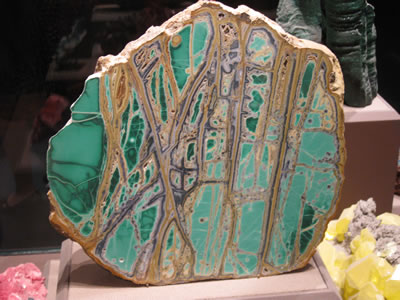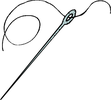 Rock on display at the Smithsonian Institution National Museum of Natural History in Washington, D.C.
Rock on display at the Smithsonian Institution National Museum of Natural History in Washington, D.C.
Truly unique style inspiration seems to be a rarity in today's apparel market. As long as the logo or "trade dress" of a brand is not infringed upon, too many companies today can get away with borrowing competitors' designs with minor changes such as color, fabric, type of seams used to sew the item or change in the number of buttons. If you think mass market clothing looks too generic, remember that patternmakers are commonly given competitors' garments and asked to make a pattern exactly to match, occasionally with a minor alteration or two. Legislation has been proposed in the United States to help increase copyright protection for clothing designs, but so much clothing is imported, and styles change so quickly, that increased copyright protection for clothing designs would be difficult to enforce.
To become a creative designer, learn to find style inspiration from varied sources, often not other clothing but in nature, architecture and from fabric itself, with the draping properties of different weaves. The top runway designers often fall into this category with their unique designs based around a concept or motif that they have chosen to inspire the season's collection.
A former classmate of this website's founder won a scholarship to study in Paris at a fashion design school. She returned from her studies to describe mood board assignments and displayed a board she had made. Her mood board was a small piece of foam board to which she had attached fabric clippings, fabric photos, feathers and a bunny rabbit mask. The design school had restricted students from using any pictures of clothing as part of their mood boards. Students could attach pictures of fabric but not clothing. When looking for inspiration through analogy to non-apparel items, the fashion students often found their most creative ideas, as this girl claimed she did.
So, how do inspirational mood boards translate to clothing design? The feathers could inspire detailed pintucks angling out from a center front seam, similar to feather barbs branching out from the shaft. The bunny mask was a whimsical item with bright contrasting colors which could be applied to the color scheme of a garment collection. The photos of fabrics with lace textures that this girl had taped to the board could inspire a wavy seam running throughout a sleeve in the same pattern that threads in one of the laces followed. What inspires you as you design clothes or shop for your own wardrobe?
This was the first post written for the original Fashion Belle website launched on November 17, 2010.
